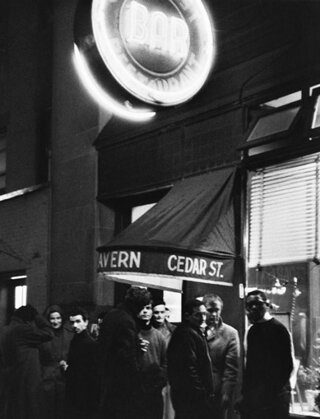 Fifty feet of mahogany, darkened in history’s dim light and smoothed by a century and a half of elbows and sliding glasses. A 13-foot, mirrored back bar, where the likes of Jack Kerouac, Jackson Pollock, Bob Dylan and Jackie Gleason checked themselves out in the ‘50s and ‘60s. The Cedar Tavern held a special place in Greenwich Village notoriety because it was where abstract expressionists and beat poets drank after artist Robert Motherwell’s weekly salons in his nearby studio. When the founder’s sons, who owned the fourth and final location near NYU, closed the beloved joint in 2006 to renovate the building as million dollar condos, the New York Times ran an op-ed piece that wondered if all the old haunts of boho legend would soon be converted to “a series of expensive, lonely boxes in which people we don’t know reside.”
Fifty feet of mahogany, darkened in history’s dim light and smoothed by a century and a half of elbows and sliding glasses. A 13-foot, mirrored back bar, where the likes of Jack Kerouac, Jackson Pollock, Bob Dylan and Jackie Gleason checked themselves out in the ‘50s and ‘60s. The Cedar Tavern held a special place in Greenwich Village notoriety because it was where abstract expressionists and beat poets drank after artist Robert Motherwell’s weekly salons in his nearby studio. When the founder’s sons, who owned the fourth and final location near NYU, closed the beloved joint in 2006 to renovate the building as million dollar condos, the New York Times ran an op-ed piece that wondered if all the old haunts of boho legend would soon be converted to “a series of expensive, lonely boxes in which people we don’t know reside.”
Sound familiar?
When a couple of Austinites heard that the Cedar Tavern was closing they both asked a question in reaction: “What are they going to do with that spectacular bar?” Stubb’s co-founders Eddy Patterson and John Scott had special memories of their time in NYC in the early ‘90s, when the Cedar Tavern, at 82 University Place between 11th and 12th Streets, was their hangout. Natives of Lubbock, they didn’t know each other until they lived in the Big Apple, where Scott went to Brooklyn Law School and Patterson managed a payroll set-up business from an office under the Manhattan Bridge. Patterson’s younger brother Bobby was a budding painter who worked at an art gallery in Soho.
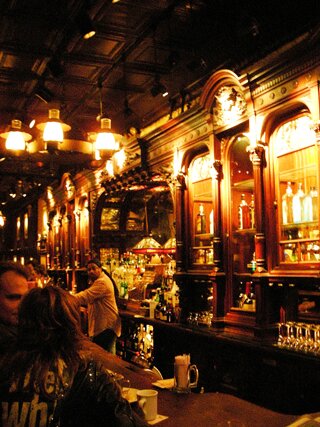
Cedar Tavern Bar in NYC. Currently in storage in Austin. Photo by Whitney Pastorek.
If you were from Lubbock and you lived in NYC, you hung out together and the Cedar Tavern was a central meeting place that was both familiar and exotic. They filmed the scenes for Requiem For a Heavyweight, starring Anthony Quinn, at the Cedar Tavern in 1962, about the time the bar, in real life, had become a haunt for folkies. This was where Dylan met with filmmaker D.A. Pennebaker to plot out filming of the 1966 documentary Don’t Look Back! The food was pretty decent.
These guys from “an island surrounded by dirt” felt so alive to be young in NYC, but a subject that always seemed to come up was that you couldn’t get decent BBQ in Manhattan. There was a place in the Village that had long lines for mediocre ‘cue, so once a month, the Lubbock crew would pool their money and send it to hometown pitmaster legend C.B. Stubblefield, who had a hole-in-the-wall brisket and ribs joint in Austin on the I-35 access road, near 38th. Stubb would cook the order and pack it in a big Igloo cooler, which he would then take to the American Airlines shipping counter at the old Mueller Airport, just a mile and a half away. The guys got that idea when the David Letterman Show, on a tip from Joe Ely, served Stubb’s air-freighted ‘cue to the studio audience one night, then booked the black man in the big hat and overalls for an in-studio appearance.
But back home, Stubb had trouble with the health department, which shut him down for evidence of roaches and rats. Ever the quirky philosopher, C.B. declared the infestation an act of God.
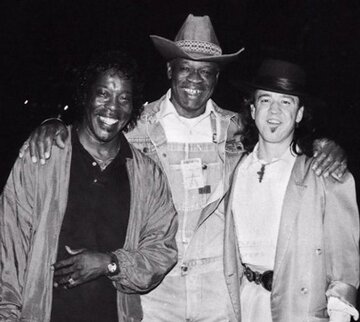
Buddy Guy, C.B. Stubblefield, Stevie Ray Vaughan circa 1984.
“Stubb was flat broke,” says Sharon Ely, whose husband Joe was a regular at the famous Sunday night jam sessions at the original Stubb’s on East Broadway in Lubbock. (The Elys are working on a documentary about the man beloved for his wisdom, style and generosity of spirit.) “We were looking for a way to help him make some money. Well, everybody loved his sauces, so we spent one day in the kitchen pouring his sauces in mason jars and selling them to friends.” The profit was $250. One day Stubb went into the dumpster behind the Continental Club and retrieved empty whiskey bottles. After some soaking and a couple passes in the dishwasher, those bottles contained the next batch of sauces and marinades. Joe Ely figured how to make labels with his Apple 2E computer and the Stubb’s sauce business was born. But limited to what Stubb could cook and bottle in the Ely’s kitchen.
Like the Elys and Kimmie Rhodes, John Scott also wanted to help his old friend, whom Scott had known since he was nine and his college professor mother took him to hear blues shows at Stubb’s BBQ joint and elsewhere. At the Cedar Tavern one night, Scott and Eddy Patterson drew up an ambitious business plan, with the goal to put Stubb’s sauces, marinades and rubs in grocery stores all over the world. C.B. was on board.
Stubb’s Legendary Kitchen was incorporated in 1992, when Scott and Patterson set up in Austin, but the first bottles of the company’s sauces were sold at high-end grocery stores in New York City, not Austin. “We delivered by taxi,” Patterson said. A 20-gallon batch yielded 105 cases.
The company, which sold $30 million worth of stuff to put on meat in 2013, almost didn’t make it to the second year. Right after they got up and running in Austin, they heard some bad news from their broker: HEB wasn’t buying any new BBQ sauce products that year. “We were crushed,” says Patterson. “We didn’t have a year.” They didn’t give up and sent two pleading letters to HEB chairman Charles Butt, who eventually agreed to a meeting and was convinced to put Stubb’s on shelves in the current buying cycle.
“Stubb lived to see his sauces at HEB,” says Sharon Ely. “That was a big deal to him.” The legendary barbecue man, who was introduced to white Lubbock musicians when he picked up guitarist Jesse Taylor hitchhiking, died at age 64 in 1995. That was a year before his namesake restaurant/ concert venue rushed to open in time for SXSW.
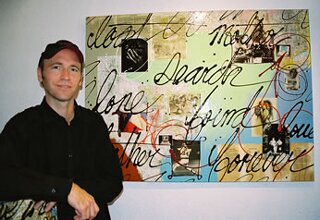
Bobby Patterson
The Cedar Tavern gang of Lubbockites was reunited in Austin in 2000, when Bobby Patterson- known better to art patrons as Robert Ellis Patterson- moved here and opened the Austin Modern Gallery. The younger Patterson brother was a force of nature, bringing all that Manhattan gallery energy to help create a vibrant visual art scene on West Third Street. But tragedy struck in Nov. 2004 when Bobby was killed at age 35 in a freak fall.
Two years later, Bobby’s best friend in NY, Tom Maitland, called Eddy. “Have you heard Cedar Tavern is closing down?” Scott and Patterson decided they’d try and buy the bar and bring it back to Texas. It took many phone calls and emails to track down the dealer in charge of selling the bar, but when Eddy finally made contact and identified himself, he was stunned when the dealer asked “Are you Bobby Patterson’s brother?” Turned out the dealer didn’t know his artist friend had recently passed away.
With this inside track, Scott and Patterson were able to make a deal to buy the bar and the back bar for $150,000, before it went to auction. “We hired fine art movers,” says Scott, “because to us we were moving a piece of art.”
The bar was taken in sections to a warehouse off Hwy 71 on the way to Bastrop, where it has remained for almost eight years. “We had to find the perfect space for it to come back to life,” says Scott. Which wasn’t easy for a bar 50-feet long and a back bar 13-feet tall.
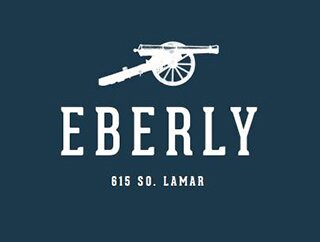
Eberly logo
But in April 2013, Scott, Patterson and third partner Burke Edwards paid $2.4 million for a 10,000 square foot building at 615 S. Lamar that formerly housed the Ridgway print shop. Renovations began in January and the trio, aided by designer Mickie Spencer of East Side Showroom and construction chief Michael Dickson of Winflo, hope to unveil Eberly, an elevated American bistro, by the end of 2014. November 19, the 10th anniversary of Bobby Patterson’s death, would be a fitting opening date.
The Cedar Tavern bar will be installed in the back room of the restaurant, where the ceiling is much higher than the entrance. The walls will hold shelves full of history and philosophy books from John Scott’s mother’s library.
History is important to the Eberly concept, named after Angelina Eberly, the woman who fired a cannon at sneaky political encroachers who tried to moved the state capitol archives from Austin to Houston in 1842. Eberly is the reason there have never been “Keep Houston Weird” t-shirts. She’s the mother protector of Austin.
And there’s no denying the history in all that mahogany and mirrored glass that moved from Greenwich Village to Travis County eight years ago. But will the spirit travel? If Austin is to be a world class city, it can’t just be a series of restored artifacts in nouveau concepts. It has to be a city where art and ideas are more than just background and brands.
Three homesick Texans sat at a bar built in 1866 and thought about tomorrow. That’s how this story of rebirth and respect started. Nostalgia means nothing if you’re not moving forward. It’s there in the title of a documentary hatched in a historic bar coming to South Lamar. Don’t look back. Memories work best when they influence your dreams.
UPDATE: It was announced on 6/24/15 that McCormick & Co. has bought the company that owned Stubb’s sauces for $100 milion. Construction on the Eberly at 615 S. Lamar Blvd. has slowed in recent months and is nowhere near completion.
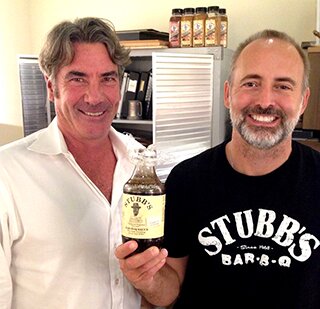
John Scott and Eddy Patterson with one of the first Stubb’s bottles. Logo designed by Joe Ely.